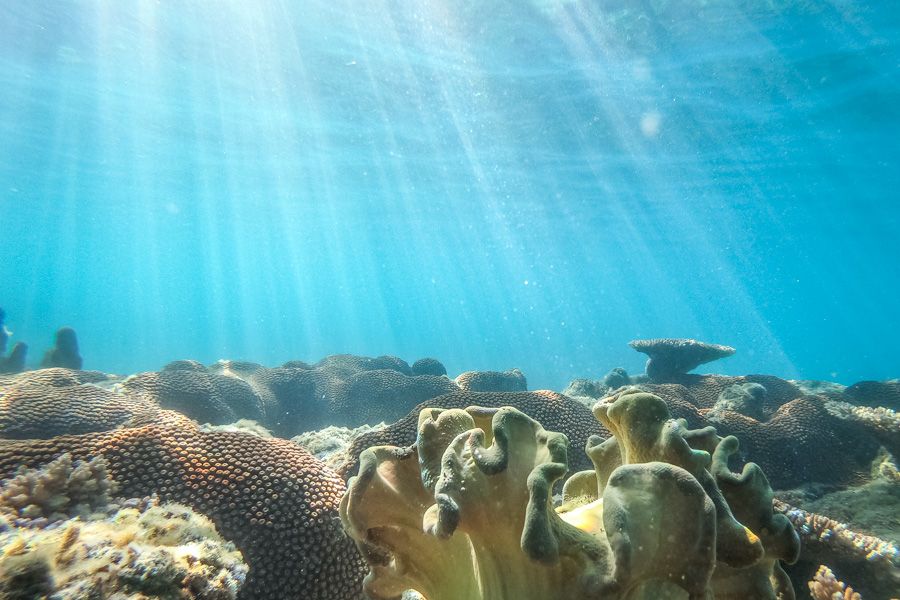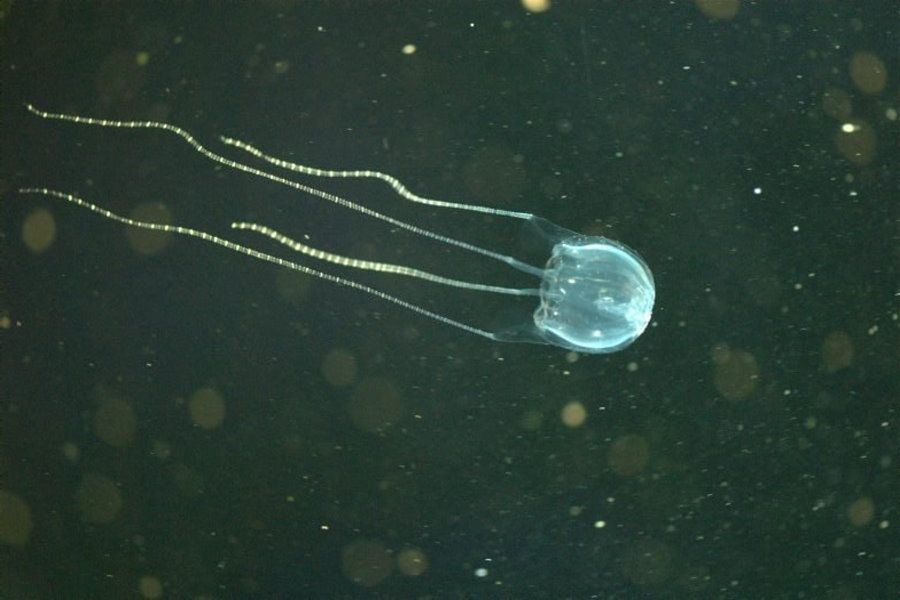Whitsundays Stinger Season
Stinger season in the Whitsundays runs during the warmer months of the Australian year, from late October until May. The warm tropical waters of the Whitsundays and Great Barrier Reef provide the ideal environment for marine stingers during stinger season, including a variety of harmful jellyfish species.
Despite this, being stung by a marine stinger species is an uncommon occurrence in the Whitsundays. It is crucial for both Whitsundays locals and visitors to stay informed and take the recommended preventative measures, including wearing a stinger suit during stinger season.
Our team of local experts are here to inform you about the Whitsunday stinger season and the recommended precautions, to ensure you have a safe and enjoyable time whilst exploring the spectacular Whitsunday Islands!

When is stinger season in the Whitsundays?
Stinger season in the Whitsundays generally runs during the warmer months of the Australian year, from October to May. The tropical Whitsundays' waters create ideal conditions for marine stingers to travel down the coastline and reproduce.

What time of year are stingers in Airlie Beach?
Airlie Beach, like the Whitsunday Islands and all of the Queensland tropics, has marine stingers between October and May. So stinger season is pretty consistent throughout all of Tropical North Queensland.
Nonetheless, varieties of marine stingers, commonly jellyfish, can be present year-round during periods of northern trade winds and king tides. Therefore it is recommended to always exercise caution before heading out into the glassy waters of the Whitsundays, especially during the summer season.
Jellyfish have limited propulsion abilities, therefore can generally be found floating along the ocean currents. With the necessary precautions taken by crew and passengers, it is an extremely rare occurrence to be stung by a marine stinger on a Whitsundays tour. If you are feeling concerned, be sure to speak with your knowledgeable crew who will inform you of the day's conditions.

Where are stingers found in the Whitsundays?
Calm waters in the Whitsundays are a high risk during stinger season, as these conditions allow marine stingers to remain stationary. High-risk conditions include sheltered bays, sandy beaches in low wave action, river mouths, and of course areas of heightened water temperature. However, marine stingers can still occur in open water and out of season, so wearing a stinger suit is always a good idea in the Whitsundays.
Stinger season doesn’t mean you can’t enjoy yourself out in the water - it just means you have to be more careful and aware that you are entering a foreign environment.
Enjoy these Whitsunday tours year-round, with stinger suits supplied during stinger season!
Chances of being stung in the Whitsundays
The chances of being stung by a marine stinger in the Whitsundays are very rare. Hundreds of thousands of people enter the world-renowned waters of the Whitsundays region every year, and there are very few recorded stinger incidents. By taking the necessary precautions, locals and visitors can enjoy their time in the water at all times of the year.
Rest assured that stings are incredibly uncommon when preventive measures are taken, as are your chance of encountering a marine stinger during your trip!

Types of Stingers in the Whitsundays
Marine stingers play an important role in the Whitsundays marine ecosystem structures, even providing food for animals such as sea turtles. Amongst the many blooms of harmless jellyfish such as moon jellies and crystal jellies, there are two types of marine stingers that swimmers should be aware of in the Whitsundays: Box jellyfish and Irukandji.
The two harmful stingers have different appearances and types of stings, and it is important to remain cautious of these stingers when entering the water.
Irukandji
Translucent and roughly the size of a fingernail Irukandji can be found in Whitsunday waters. An Irukandji sting results in severe pain generally within 5-40 minutes and can have life-threatening effects on the heart. Dowsing with vinegar immediately for at least 30 seconds is recommended by the Queensland Ambulance Service.
Box jellyfish
Easier to spot, Box jellyfish can be distinguished by their large cubed bell and long tentacles. A Box jellyfish's sting is extremely life-threatening, as the venom has severe effects on the heart, nervous system, and skin cells. Dowsing with vinegar immediately for at least 30 seconds is recommended by the Queensland Ambulance Service.
Bluebottles
Also easy to spot Bluebottles are dark blue in colour and have the appearance of a bottle-shaped bell. There are no confirmed fatalities from Bluebottles stings, however, the stings do cause pain and swelling. Immersing the sting immediately in hot water is the best option to stop the sting.

Stinger season precautions in the Whitsundays
1) Wear a stinger suit
During stinger season in the Whitsundays, it is highly recommended that all visitors wear a protective stinger suit when entering the water. Stinger suits (lightweight wetsuits) are provided to each guest on a day or overnight tour, at little or no cost, to minimise any risk of being stung whilst swimming, snorkelling, or diving in the Whitsundays waters. As well as keeping you safe, stinger suits are a great way to keep protected from the Queensland summer sun.
A stinger suit will cover your body from neck to ankles, decreasing your already extremely slim chances of being stung by 75%. Pregnant women, the elderly, and children are more susceptible to the harmful effects of a jellyfish sting, so they may opt to cover up further with a head cap, gloves, and reef shoes. During the winter months, it is wise to still wear a rash shirt, as the most important area to protect is your chest.
Our experienced crew also recommends wearing a stinger suit during stinger season if you go for a dip in the swimming enclosures off Airlie Beach. Smaller types of jellyfish can enter these areas and get trapped in the enclosures. Suits can be hired or bought at several shops in Airlie Beach, including the dive shop at Abell Point Marina.
2) Carry vinegar
All vessels and crews heading out on a day or overnight tour will have the supplies and training to act immediately if someone is stung by a jellyfish. However, if you are swimming offshore on an unpatrolled beach, it is advised to see if they have a stinger station nearby that will generally have stinger advice and a bottle of vinegar in case of emergencies.
If you plan to travel independently around the Whitsundays it is a good idea to carry your own bottle of vinegar in your pack, especially during stinger season. Make sure to never touch a jellyfish that has washed up on the shore, as their stingers can still have active venom.
3) Know the winds and conditions
Although jellyfish most commonly occur in the Whitsundays from October to May, varieties of jellyfish can be present year-round during periods of northern winds and king tides.
If you're unsure of what precautions to take, particularly during the cooler months, be sure to ask your experienced crew, who will inform you of the current and recent winds and conditions.

How to treat a jellyfish sting
Irukandji, box jellyfish, bluebottles, and other dangerous species can be found in the Whitsundays and can cause severe reactions in people. Reactions range from serious stings to cardiac arrest, so it is important to treat stings properly to prevent further damage.
Treatment can range between stinger species, dowsing with vinegar is recommended for most jellyfish stings, while this is not recommended for Bluebottles. Instead, immersing the sting in hot water is the best option to stop the sting.
Although it is a very rare occurrence, always alert your highly-trained crew immediately if you have been, or believe you have been stung whilst in the Whitsundays!
Queensland Government issued procedure if yourself or someone is stung:
- Call for medical help (ring 000) (or if you are on a tour, alert your qualified crew members).
- Assess the patient and perform CPR if necessary.
- Remove any remaining tentacles carefully, preferably with a glove.
- Douse the sting site with vinegar as soon as possible. Vinegar inactivates the stinging cells, preventing them from injecting more venom.
- Reassure the patient and keep calm until medical help arrives.
- Wait at least 45 minutes before re-entering the water as symptoms of Irukandji syndrome can take a while to develop.
- If in doubt, treat as Irukandji.
Protected areas to swim on the Whitsunday mainland
The best way to experience the crystal-clear waters of the Whitsunday Islands is on an adventure-filled day or overnight tour, that provides each guest with a stinger suit, for little or no cost. However, for those holidaymakers and sun-seeking travellers spending time on the Whitsunday mainland, there are several places you can take a refreshing stinger-free swim in Airlie Beach and surrounds!
If you are visiting a beach with a stinger net on the Whitsunday mainland, we do recommend wearing a stinger suit during stinger season. Smaller types of marine stingers, such as Irukandji, can enter these areas and get trapped in the enclosures. Suits can be hired or bought at several shops in Airlie Beach, including the dive shop at Abell Point Marina.
The Airlie Beach Lagoon
Located in the centre of town, the Airlie Beach Lagoon is completely free for all visitors and offers more than 4,000 square metres of space. The lagoon is patrolled by lifeguards and boasts picture-perfect views of the adjacent Coral Sea, creating a safe and monitored swimming spot for everybody to enjoy!
Cedar Creek Falls
Situated a 30-minute drive from Airlie Beach near the small town of Proserpine, the Cedar Creek Falls are a perfect road trip destination and freshwater haven on a wet season day! A hidden Whitsundays gem, visitors can enjoy a refreshing swim in the unique natural rock amphitheatre.
Whitsunday mainland beaches with stinger nets
When you're not exploring the silica sands of Whitehaven Beach, the Whitsundays mainland has several sandy beaches with a stinger net, that provide a sheltered swimming spot during stinger season. From Airlie Beach to Bowen, be sure to check one of these amazing Whitsunday mainland beaches!
- Boathaven Beach, Airlie Beach
- Dingo Beach, Hydeaway Bay
- Horseshoe Bay, Bowen

Time to put on that stinger suit and rest assured that you are in for a holiday filled with swimming and snorkelling adventures at all times of the year, armed with extensive knowledge of these incredible (and very rare) marine creatures!
Planning your dream getaway to the Whitsundays, and unsure on what day or overnight tour to book?













